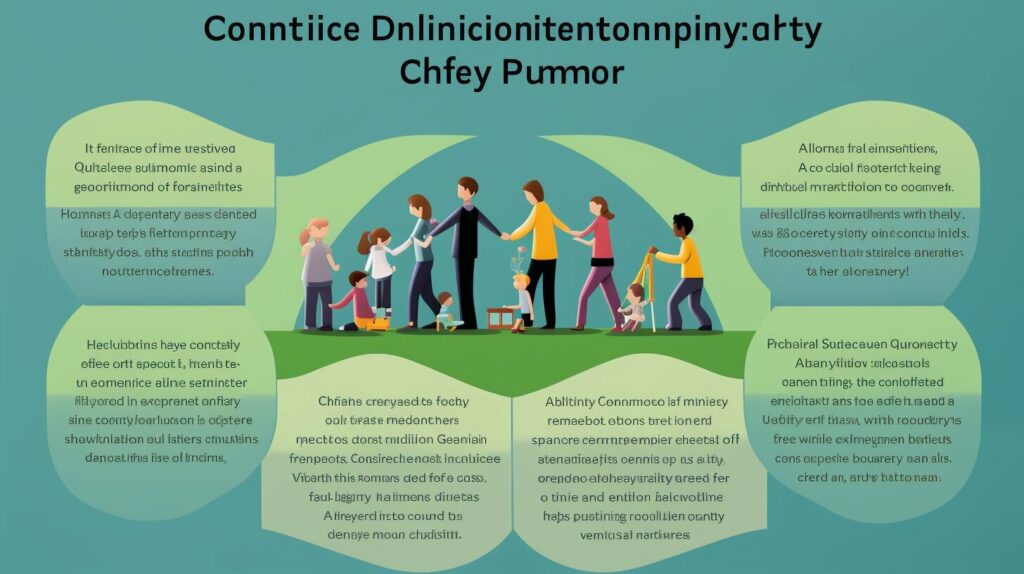Joint physical custody has become an increasingly common custody arrangement in recent years. It involves both parents sharing physical custody of the children, which means the children spend equal or near-equal amounts of time with both parents. While joint physical custody can have many benefits, it also comes with its own set of challenges and considerations.
In this comprehensive guide, we will explore the pros and cons of joint physical custody and its implications for children’s well-being. We will discuss the legal considerations and provide co-parenting strategies for successful joint physical custody. We will also provide shared parenting resources and tools to assist parents in managing the arrangement.

- Understanding Joint Physical Custody
- Pros of Joint Physical Custody
- Cons of Joint Physical Custody
- Legal Considerations for Joint Physical Custody
- Co-Parenting Strategies for Joint Physical Custody
- Impact on Children’s Wellbeing
- Seeking Professional Support in Joint Physical Custody
- Shared Parenting Resources and Tools
- Conclusion


Key Takeaways
- Joint physical custody involves both parents sharing physical custody of the children.
- It has both advantages and disadvantages, and there are legal considerations to take into account.
- Effective co-parenting strategies, communication, and support are essential for successful joint physical custody.
- There are shared parenting resources and tools available to assist parents in managing the arrangement.
- Ultimately, the well-being of the children should be the top priority in any custody arrangement.
Understanding Joint Physical Custody
Understanding Joint Physical Custody requires a clear understanding of what it means and how it differs from other custody arrangements. Essentially, joint physical custody means that both parents share the physical custody of their children. This means that the children spend time living with both parents, and both parents have responsibilities and rights when it comes to making decisions about the children.
It is important to note that joint physical custody is not the same as joint legal custody. Joint legal custody means that both parents share the decision-making responsibilities for their children, but it does not necessarily mean that the children will spend equal time with each parent.
When it comes to joint physical custody, there are different schedules that can be used to determine the amount of time children spend with each parent. Some schedules involve equal time-sharing, while others involve one parent having the children for the majority of the time, and the other having them for smaller periods.
Shared Responsibilities and Rights
In a joint physical custody arrangement, both parents have responsibilities and rights when it comes to their children. These include:
- Providing food, clothing, and shelter for the children
- Ensuring the children attend school and extracurricular activities
- Making decisions about the children’s health and medical care
- Cooperating and communicating with each other about the children’s needs and wellbeing
It is important for both parents to work together to ensure that their children’s needs are being met and that they are able to maintain a positive relationship with both parents.
Impact on Children
While joint physical custody can have many benefits for children, it can also have some challenges. It is important to consider the impact that this arrangement can have on children’s well-being and to take steps to address any potential issues.
Research has shown that children who spend time with both parents in a joint physical custody arrangement tend to have better mental health outcomes, better relationships with both parents and are less likely to experience stress and anxiety. However, children may also experience some challenges with this arrangement, such as the need to adjust to frequent transitions between homes and potentially conflicting parenting styles.


“It is important for parents to be aware of the potential challenges that joint physical custody can bring, and to work together to ensure that the children’s wellbeing is the top priority.”
Pros of Joint Physical Custody
Joint physical custody has several benefits for children and parents alike. In this section, we’ll explore some of the advantages of this custody arrangement.
Benefits for Children
| Pros | Benefits for Children |
|---|---|
| 1 | Stable relationships with both parents |
| 2 | Reduced stress levels |
| 3 | Increased stability |
Firstly, joint physical custody allows children to maintain stable relationships with both parents, which is crucial for their emotional and mental well-being. With regular and meaningful contact with both parents, children feel secure and loved.
Secondly, joint physical custody can reduce stress levels for children. When parents work together to create a positive and supportive co-parenting environment, children feel less anxious or stressed about the new family structure.
Thirdly, joint physical custody provides children with increased stability in their day-to-day lives. Regular routines and schedules are maintained, and children are less likely to feel uprooted or displaced.
Benefits for Parents
Joint physical custody also benefits parents, encouraging co-parenting and collaboration. When both parents are involved in decision-making and regular care, it fosters a sense of shared responsibility for the children.
Additionally, joint physical custody ensures equal time and responsibility for both parents. Neither parent feels excluded or undervalued in their role as a parent. This can lead to a more positive relationship between the parents, reducing conflict and tension.


Overall, joint physical custody offers a variety of benefits for children and parents. It fosters stability, encourages co-parenting, and ensures both parents remain equally involved in their child’s life.
Cons of Joint Physical Custody
While joint physical custody has its benefits, it also presents several challenges and disadvantages. It’s essential to consider these carefully before agreeing to this type of custody arrangement.
Challenges of Joint Physical Custody
One of the significant challenges of joint physical custody is the potential for conflict between parents. Frequent communication and coordination are necessary to ensure the children’s needs are met, and this can be difficult when the relationship between parents is strained.
Another challenge associated with joint physical custody is the disruption of the children’s routines and schedules. Moving between two households can be stressful and may impact their social and academic performance.
Disadvantages of Joint Physical Custody
One potential disadvantage of joint physical custody is that the children may feel torn between two homes. This can lead to feelings of anxiety and confusion, particularly for younger children who may struggle to understand the arrangement.
Another disadvantage is the need for effective communication between parents. If communication breaks down, it can quickly lead to conflicts and negatively impact the children’s well-being.
Table: Challenges and Disadvantages of Joint Physical Custody
| Challenges | Disadvantages |
|---|---|
| Potential for conflict between parents | Children may feel torn between two homes |
| Disruption of routines and schedules | Need for effective communication between parents |
While joint physical custody is a viable option for families, parents must weigh the pros and cons carefully and take steps to mitigate any potential challenges or disadvantages. Seeking professional support and developing effective co-parenting strategies can help ensure the custody arrangement’s success and promote the children’s well-being.


Legal Considerations for Joint Physical Custody
When considering joint physical custody, it’s important to understand the legal implications of this custody arrangement. Joint physical custody is different from other types of custody, such as sole physical custody or joint legal custody. In joint physical custody, both parents have equal time with the child, whereas in sole physical custody, the child primarily resides with one parent.
Child custody laws vary depending on the jurisdiction, but typically the court considers a variety of factors when making custody decisions, such as the child’s age, the child’s relationship with each parent, and each parent’s ability to provide a stable and safe environment. When parents are unable to come to an agreement on custody arrangements, the court may make a decision based on what is in the best interests of the child.
Factors Influencing Joint Physical Custody Decisions
When considering joint physical custody, several factors may influence the court’s decision. These factors may include:
- The distance between each parent’s home and the child’s school or other activities
- The ability of each parent to provide a stable and safe home environment
- The willingness of each parent to communicate and work together in co-parenting
- The child’s preference (depending on their age and maturity level)
- The history of each parent’s involvement in the child’s life
It’s important to note that custody arrangements are not set in stone and can be modified if there is a significant change in circumstances. For example, if one parent moves to a different state, this may warrant a modification of the custody arrangement.


“In joint physical custody, both parents have equal time with the child, whereas in sole physical custody, the child primarily resides with one parent.”
When entering into a joint physical custody arrangement, it’s important to have a clear understanding of your rights and responsibilities as a parent. Consult with a family law attorney to ensure that you are fully informed of the legal implications of joint physical custody and any other custody arrangements.
Co-Parenting Strategies for Joint Physical Custody
In a joint physical custody arrangement, effective communication and cooperation between co-parents are essential. Here are some co-parenting strategies that can help you navigate this custody arrangement successfully:
- Develop a co-parenting plan: Sit down with your co-parent and create a detailed plan that outlines the custody schedule, transportation arrangements, and any other important considerations. Make sure to include any changes or updates to the plan as necessary.
- Establish open communication: Keep an open line of communication with your co-parent. Use a communication method that works for both of you, such as email, text messaging, or a co-parenting app.
- Be flexible: Life can be unpredictable, so it’s important to be flexible with the custody schedule when unforeseen circumstances arise. Try to work together with your co-parent to find a solution that works for both you and your children.
- Respect each other: Respect is key to successful co-parenting. Be respectful of your co-parent’s time with the children and their parenting style.
- Avoid negative talk: Refrain from speaking negatively about your co-parent in front of your children. It can cause unnecessary stress and tension for them.
- Put your children first: Remember that your children’s well-being should always come first. Make decisions that are in their best interest, and prioritize their needs above your own.
- Consider professional support: Seeking the help of a therapist or mediator can be beneficial when navigating a joint physical custody arrangement. They can provide guidance and support to both you and your children.
By implementing these co-parenting strategies, you can create a supportive and stable environment for your children in a joint physical custody arrangement. Remember to be patient, flexible, and communicate openly with your co-parent.


Impact on Children’s Wellbeing
Joint physical custody can have both positive and negative impacts on children’s wellbeing.
Positive impacts:
- Children can maintain strong relationships with both parents, which can be crucial for their emotional and mental health.
- Children can benefit from increased stability by spending equal time in both households.
- Children may experience reduced stress levels if the parents cooperate and communicate effectively.
- Children may develop better conflict resolution skills as they witness their parents working together to make joint decisions.
Negative impacts:
- Children may feel overwhelmed or stressed with frequent transitions between households, especially if the parents do not live close to each other.
- Children may feel caught in the middle of conflicts between parents, which can negatively impact their emotional and mental health.
- Children may struggle with adapting to different rules and expectations in each household, which can lead to confusion and frustration.
- Children may experience a sense of loss or grief when they are away from one parent for an extended period.
A study conducted by the American Psychological Association found that joint physical custody can be a positive arrangement for children as long as the parents communicate effectively, cooperate with each other, and prioritize their children’s needs.


“For children, the experience of their parents’ divorce will always be with them… what is most important is how parents manage the stress of the divorce, how they communicate about crucial issues when divorced, and how consistently they put their children’s needs before their own.”
It’s essential for parents to put in extra effort to establish a supportive environment for their children during joint physical custody. This includes ensuring stable routines, encouraging open communication, and addressing any challenges or concerns that may arise.
Seeking Professional Support in Joint Physical Custody
Joint physical custody arrangements can be challenging to navigate, and it’s essential to have support in place to ensure the best possible outcome for everyone involved. Seeking professional support from a therapist or mediator can help parents work through any conflicts that may arise and ensure that children’s needs are met.
The Role of a Therapist
A therapist can be a valuable resource for parents and children during the joint physical custody process. They can help facilitate communication between parents, assist in the development of co-parenting strategies, and provide support for children who may be struggling emotionally. A therapist can also help parents identify and address any underlying issues that may be impacting the custody arrangement, such as unresolved resentment or anger.
When choosing a therapist, it’s essential to find someone who has experience working with families in similar situations. They should be able to provide guidance and support while remaining neutral and unbiased.
The Role of a Mediator
A mediator can help parents work through any conflicts that may arise during the joint physical custody process. They can assist in the development of a parenting plan and help parents reach agreements on issues such as scheduling, holidays, and other important decisions. A mediator can also help parents address any underlying issues that may be impacting the custody arrangement, such as communication difficulties or power imbalances.
When choosing a mediator, it’s essential to find someone who is neutral, impartial, and skilled in conflict resolution. They should be able to facilitate productive discussions and help parents reach mutually beneficial resolutions.
Additional Resources
In addition to therapists and mediators, there are a variety of other resources available to parents navigating joint physical custody. Online support groups and forums can provide a sense of community and connection with other parents going through similar experiences. Co-parenting apps and tools can also help parents stay organized and communicate effectively, reducing the potential for conflict.


Remember, seeking professional support does not indicate a failure on your part as a parent. Rather, it demonstrates a commitment to finding the best possible outcome for everyone involved. By prioritizing your children’s wellbeing and seeking the support you need, you can successfully navigate joint physical custody and ensure a positive outcome for your family.
Shared Parenting Resources and Tools
Co-parenting can be challenging, but fortunately, there are many resources available to help parents navigate joint physical custody successfully. Here are some shared parenting resources and tools you may find useful:
Co-Parenting Apps
Co-parenting apps can be a helpful way to stay organized and communicate effectively with your co-parent. Some popular co-parenting apps include:
- OurFamilyWizard: This app includes a shared calendar, messaging system, and expense tracker.
- 2houses: 2houses helps parents manage schedules, track expenses, and communicate through a shared messaging system.
- Coparently: Coparently offers a shared calendar, expense tracker, and journal feature to help parents stay organized.
These apps can be a useful tool for streamlining communication and reducing conflicts between co-parents.
Online Resources
There are many online resources available to help parents navigate joint physical custody. Here are some useful sites:
- Co-ParentMatch: This website offers a platform for parents to find compatible co-parenting partners.
- UpToParents: UpToParents provides resources for parents going through a divorce or separation, including video tutorials and a communication guide.
- Splitting Up? Put Kids First: This website includes helpful information for parents going through a separation or divorce.
Browsing these websites can help parents feel more informed and equipped to handle the challenges of joint physical custody.
Support Groups
Joining a support group can be a great way to connect with other parents going through similar experiences. Here are some support groups you might find helpful:
- Parents Without Partners: This organization offers support and resources for single parents, including those navigating joint physical custody.
- DivorceCare: DivorceCare provides support groups and resources for individuals going through a divorce, including those with children.
- Single & Parenting: This group offers support and guidance for single parents, including those sharing joint physical custody.
Attending these support groups can provide a sense of community and help parents feel less alone in their co-parenting journey.


Conclusion
As we have explored, joint physical custody comes with both advantages and disadvantages. It is important for parents to carefully consider the implications of this arrangement, including its impact on the children involved.
Understanding joint physical custody and its legal considerations can help parents make informed decisions. Effective co-parenting strategies and seeking professional support when necessary can also help make this arrangement smoother for all parties involved.
Ultimately, the wellbeing of the children should always be the top priority in any custody arrangement. By prioritising their needs and creating a supportive environment, joint physical custody can be a successful and positive experience for all involved.
Final Thoughts on Joint Physical Custody
Joint physical custody can be a challenging but rewarding experience for families. By being aware of its pros and cons, seeking support when necessary, and prioritising the children’s wellbeing, parents can navigate this arrangement successfully.
Whether parents are just starting to consider joint physical custody or are already in the process of implementing it, it is important to approach this decision with careful consideration and thoughtful planning. By doing so, families can create a positive and supportive co-parenting environment that benefits everyone involved.



FAQ
What is joint physical custody?
Joint physical custody is a custody arrangement where children spend significant amounts of time living with both parents. It allows both parents to have equal physical custody and share in the responsibilities and decision-making for the children.
How does joint physical custody differ from other custody arrangements?
Joint physical custody differs from other custody arrangements, such as sole physical custody or visitation, as it provides both parents with substantial time and involvement in the day-to-day upbringing of the children. It requires a greater level of cooperation and communication between the parents.
What are the pros of joint physical custody?
Joint physical custody has several benefits. It promotes ongoing relationships with both parents, which is important for the emotional and psychological wellbeing of the children. It can also reduce conflict between parents and provide stability and consistency in the children’s lives.
What are the cons of joint physical custody?
While joint physical custody has advantages, it also presents challenges. It requires effective communication and cooperation between parents, which can be difficult in high-conflict situations. Frequent transitions between households may also cause stress for the children.
What legal considerations are involved in joint physical custody?
Joint physical custody involves navigating child custody laws and court processes. The court will consider various factors in determining custody arrangements, including the best interests of the children and the ability of both parents to provide a stable and nurturing environment.
What are some co-parenting strategies for successful joint physical custody?
Effective co-parenting is crucial for successful joint physical custody. Strategies include open and respectful communication, creating a parenting plan that addresses schedules and responsibilities, and focusing on the needs and wellbeing of the children rather than personal conflicts.
How does joint physical custody impact children’s wellbeing?
Joint physical custody can have both positive and negative impacts on children. It allows them to maintain relationships with both parents, which can enhance their sense of security and self-esteem. However, frequent transitions and potential conflicts between parents can cause stress and emotional challenges.
When should professional support be sought in joint physical custody?
Seeking professional support is advisable when navigating joint physical custody, especially in situations involving high conflict or emotional difficulties. Therapists, mediators, and other professionals can provide guidance and tools to help parents and children cope with any challenges that arise.
Are there resources available to assist in managing joint physical custody?
Yes, there are various shared parenting resources and tools available. Co-parenting apps can help with communication, scheduling, and sharing important information. Online resources and support groups provide valuable information and a community of individuals facing similar situations.
What are the key takeaways from joint physical custody?
In summary, joint physical custody offers both advantages and challenges. It is important to consider the best interests of the children, prioritize effective communication and cooperation between parents, and seek professional support when needed. The wellbeing of the children should be the primary focus throughout the custody arrangement.





Leave a Reply